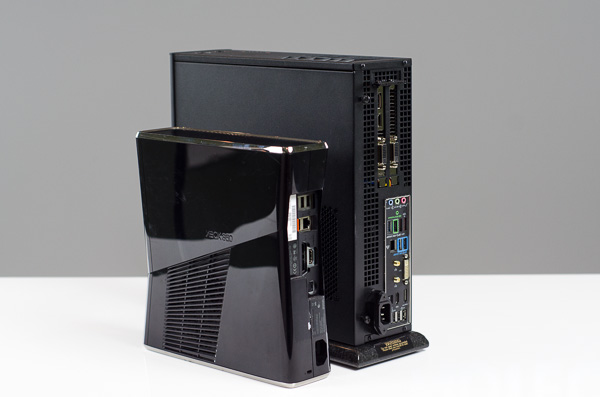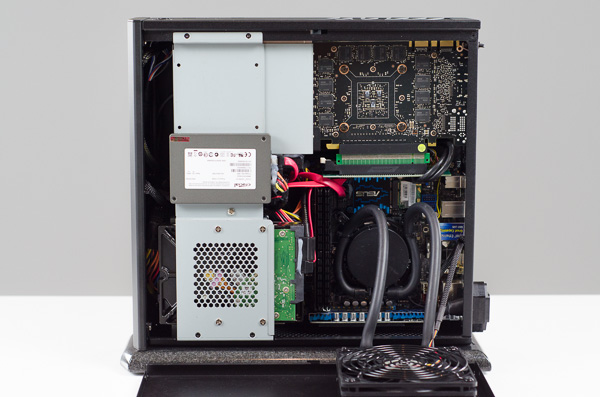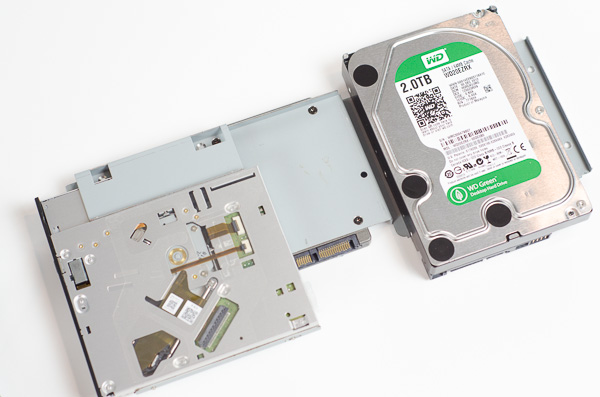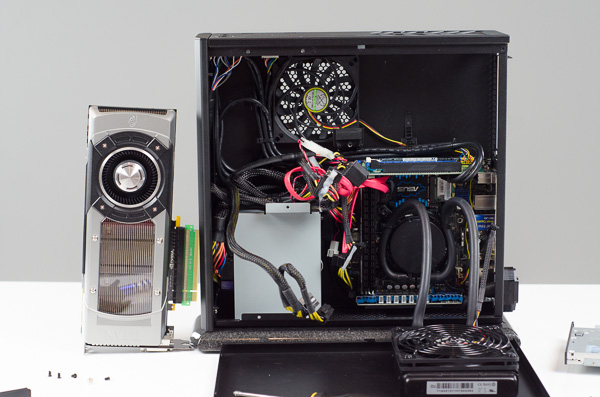High-End Meets Small Form Factor: GeForce Titan in Falcon Northwest's Tiki
by Anand Lal Shimpi on February 19, 2013 9:00 AM ESTInside the Tiki
The Tiki tower is quite compact, measuring just 4" wide. It's bigger than a new Xbox 360, but not by a huge margin. Once you consider how much more powerful this Titan equipped Tiki is, the 360 comparison becomes downright ridiculous.

Falcon NW Tiki (left) vs. Xbox 360 slim (right)
To keep the Tiki planted and from falling over, Falcon mounts it on a granite base. My review sample had a speckled black base, which seemed to be the more subtle of the available options. I appreciated the functionality of the base and the fact that my PC was sitting on a slab of granite sort of faded away. It's difficult to describe the visual impact of the Tiki chassis. Tiki's industrial design doesn't break new ground, but its aesthetic does scream sleek gaming PC. I like it. It's well executed.

Xbox 360 slim (left) vs. Falcon NW Tiki (right)
There are two USB 3.0 ports at the top of the chassis, along with a pair of audio jacks for your mic and headset. The slot loading DVD drive is also accessible from the top of the chassis. Around back you're quickly reminded that this is definitely a high-end gaming PC. There are the twin DL-DVI ports, HDMI and DisplayPort outputs driven by the GeForce Titan, as well as two eSATA ports, four USB 3.0 ports, four USB 2.0 ports, GigE, and all of the display outputs driven by the processor graphics. The ASUS board also integrates WiFi, which you can connect an external antenna to. Your standard set of analog and optical audio jacks round out the coverage. All of the labels on the IO panel are upside down so that you can lean over the top of the chassis and they appear right side up when you're plugging things in back there. It's a nice touch.
There's a healthy amount of ventilation built into the chassis. I kept a close eye on temperatures during my testing and never felt worried that I was cooking anything inside (CPU temperatures seemed to hover around 53C during heavy gaming workloads).
Despite its small form factor, the Tiki tower is remarkably simple to get inside and work on. Two thumbscrews hold the service cover in place. There's an Asetek closed loop liquid cooler mounted on the CPU, with its radiator fan mounted on the service cover so you have to be careful when opening up the machine. There's enough slack in the cooling tubes for you to lay the cover down and work on the inside of the Tiki without removing the CPU cooler.
While the Tiki normally comes with a Core i5-3470, Kelt tossed in a Core i7-3770K overclocked to 4.6GHz in my review system. Falcon will perform a factory overclock on your system for free, although there's no guarantee of what speed you'll end up with.
A total of five screws hold the drive assembly in place. There's room for two 2.5" SSDs, a 3.5" HDD and a slim optical drive in the Tiki. My review sample was outfitted pretty much the way I'd build it, with a 256GB SSD and a 2TB WD Green hard drive for data storage (ok, admittedly I'd probably toss in a 512GB SSD). Falcon offers a Blu-ray drive, but my review unit had a DVD-RW instead. I don't remember the last time I used a CD or DVD to be honest. All of the power and SATA cables are glued in place (likely to ensure safe transport), although you can easily remove them if you need to.
Today the Tiki ships with a Crucial m4 SSD by default, although Kelt is eagerly awaiting the arrival of the M500. I'm glad to see that Falcon isn't using a bad drive in the Tiki, and that the system comes with an SSD by default.
You do have to remove the drive assembly to gain access to the Titan card. A single retention screw and two bracket screws hold the GeForce Titan in place. Removing those will let you pull the card out should you need to replace it (or take photos of it).
I didn't go all the way and pull out the ASUS P8Z77-I Deluxe motherboard, but you can see how the board is surprisingly accessible once you've pulled the drive assembly out of the chassis. Other than the motherboard, only the SilverStone 450W SFX power supply would need some effort to remove.
The Tiki struck me as a good combination of a compact infrastructure that remained relatively serviceable.




















33 Comments
View All Comments
gandergray - Tuesday, February 19, 2013 - link
Impressive engineering from Falcon NW.xenol - Tuesday, February 19, 2013 - link
Part of me thinks manufacturers should start selling those PCI-Express riser cards so people can build thin mini-ITX builds.NIGHTSCOUT - Tuesday, February 19, 2013 - link
Yes, you can buy PCIe risers on ebay. For a few years now.Death666Angel - Wednesday, February 20, 2013 - link
Pretty much this. Although, mainstream case support isn't there yet. There are many more mITX cases that have a small cube like footprint than there are small tower like footprints. And if they go the narrow tower route, often they offer the riser card as part of the case. :)IanCutress - Tuesday, February 19, 2013 - link
Would be interesting to compare the weight of the Tiki against the consoles. I'm never too keen on putting my CDs, DVDs or games into a sideways mounted drive, so I wonder if the granite base is detachable (or optional) so you can put it on its side.piroroadkill - Tuesday, February 19, 2013 - link
One side would block the exhaust for the CPU, the other would block the intake for the GPU, so I don't think that's a good idea.Maybe if you put it on blocks. But then you've ruined the look of the setup.
IanCutress - Tuesday, February 19, 2013 - link
Very good point. I'm just always wary of scratching disks when putting them in sideways if they don't have a slot loader.Guspaz - Tuesday, February 19, 2013 - link
If you're loading a blu-ray disc, you're extremely unlikely to scratch it in that manner, since they're all coated (with stuff like TDK Durabis or the like).wolrah - Tuesday, February 19, 2013 - link
I'd just wonder really how important loading discs actually is to the modern PC market.Games? I'm pretty sure the original World of Warcraft was the last one I installed from CD.
OS? Microsoft has an official tool for loading Vista or newer ISOs or CDs to USB drives, and it installs MUCH faster from even a slow USB drive in my experience.
Media? If you insist on sticking with disc-based systems a standalone Blu-ray player is cheaper than a game most days and will play anything that matters. Otherwise digital libraries are the way to go. The discs I own for the most part get opened once, to rip them to my media server, at which point they are shelved forever because why would I ever want to use discs when I can just click my remote?
freedom4556 - Tuesday, February 19, 2013 - link
All the optical medial hate. So far 2x dvd read speed (22.16 Mbit/s) is still faster than the average broadband speed in the States (15.91 Mbps). Fully half of all the games I have on Steam were bought on Amazon or in the store and then I activated the keys in steam to have backups. It takes forever to install games from scratch. Hell, the initial patching alone can take hours. Personally I scorn digital distribution and love things like redbox and Hastings. What can I say, I'm a sucker for instant gratification.Sources:
http://www.netindex.com/download/2,1/United-States...
http://en.wikipedia.org/wiki/DVD#Technology